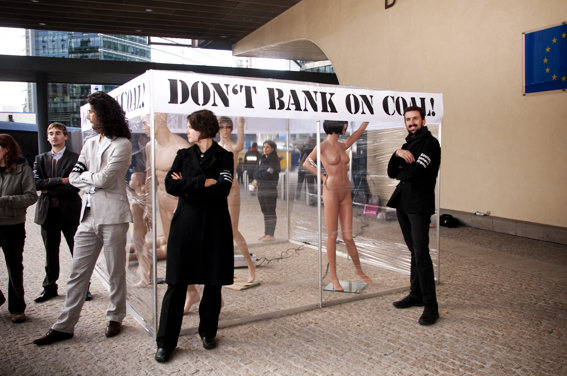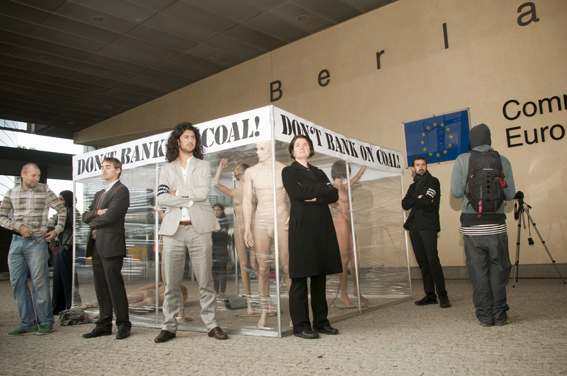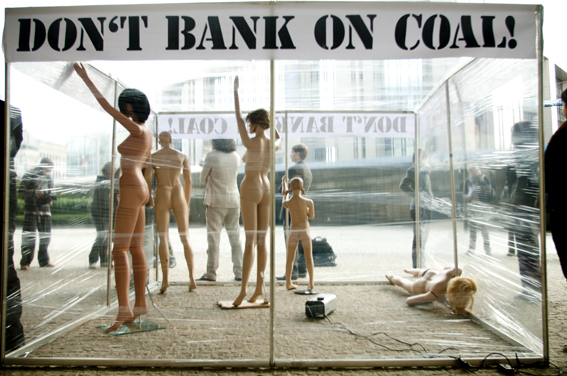Art installation at Berlaymont denounces banking on coal
Brussels – With an art installation that symbolizes EU citizens locked in a polluted environment, the Slovenian artist Marko Kumer Murč and Slovene environmentalists from Focus protest against European public and private banks pouring hundreds of millions of euros into a new lignite plant in their country, at Sostanj. Many Slovenians oppose this project and the Slovenian parliament has just refused to support a state guarantee for the banks’ loans. The action is supported by the international NGOs Banktrack and CEE Bankwatch Network, which are campaigning against the project.
19 October 2011

Photos from the installation are below. More images (and higher resolutions) are available on the photographers Flickr profile.
Brussels – With an art installation that symbolizes EU citizens locked in a polluted environment, the Slovenian artist Marko Kumer Murč and Slovene environmentalists from Focus protest against European public and private banks pouring hundreds of millions of euros into a new lignite plant in their country, at Sostanj. Many Slovenians oppose this project and the Slovenian parliament has just refused to support a state guarantee for the banks’ loans. The action is supported by the international NGOs Banktrack and CEE Bankwatch Network, which are campaigning against the project.
The installation consists of a metal cube filled with smoke inside which several mannequins are trapped, with no way of escaping, representing an environment in which people are trapped in pollution. Outside of the cube, several volunteers dressed up in suits represent the bankers and politicians that support and invest in this project, thus keeping the people stuck in an unhealthy environment.
“We, the people who do not want this plant near our homes, who will inhale its fumes for decades, have tried in many ways to say we do not want it,” explains Murč. “No one really listens and this makes us angry. Finally, my art installation represents this anger and sadness crystallized. We must be heard.”
A new 600 MW lignite plant is planned to be built at Sostanj, in north-west Slovenia. The costs of the plant are estimated at 1.3 billion Euros, and 750 million Euros out of this amount are to be covered with loans from the European Investment Bank (the largest amount), the European Bank for Reconstruction and Development, and several private Western banks, including KA Finanz AG (Austria), Landesbank Hessen-Thuringen Girozentrale (Germany), Societe Generale (France), Caja de Ahorros y Monde de Piedad de Madrid (Spain), and Unicredit (Italy).
By 2050, together with all other EU members, Slovenia will have to reduce its overall CO2 emissions by at least 80 percent. The new block at Sostanj alone would take up almost all of the country’s emissions allowance if the required reduction is achieved. [1] In practice, this means that either Slovenia gives up the idea of building this plant or it will have to break its emissions reduction commitments as an EU member.
The Sostanj project is controversial not only for environmental reasons. Earlier this year, the Slovenian government issued a report in which it raised serious questions over the economic viability of this project. Additionally, the report brought allegations of corruption against the management at Sostanj. The Slovenian police are currently conducting an investigation into the corruption claims.
The Slovenian government failed to provide a state guarantee for the EIB loan before it had to step away in September, which motivated a group of parliamentarians to trigger a procedure for adopting a law on state guarantee for the EIB loan. This month, however, the Slovenian parliament refused to pass the proposed law on state guarantee for the EIB loan for this plant. This gave a clear signal that now is a time for the European public and private banks to reevaluate their involvement in a project that is marred by corruption, economic and environmental concerns.
“Many Slovenians oppose having a new lignite plant in our country and would prefer investments in energy efficiency and renewables,” says FOCUS’ Lidija Zivcic. “The European Union is committed to reducing its carbon emissions and some Western European countries are taking measures to limit fossil fuels use. It is deeply wrong that, while Western European countries are starting to clean up the mess in their own backyards, their private banks and EU-sponsored public banks try to make a profit out of building a new coal plant that would choke us Slovenians for decades. We want these banks to get out of this project and the time to pull out is now!”
For more information, contact:
Lidija Zivcic
Senior expert, FOCUS association for sustainable development
Tel: +386 15154080
lidija AT focus.si
Mel Denes
European Coal Finance Campaign Coordinator, Banktrack
Tel: +32 (0)488 697756
mel.denes AT netwerkvlaanderen.be
Notes for the editors:
1. Information about the new plant and how much environmental damage it would produce can be found at:
https://bankwatch.org/our-work/projects/sostanj-lignite-thermal-power-plant-unit-6-slovenia





Never miss an update
We expose the risks of international public finance and bring critical updates from the ground – straight to your inbox.
Institution: EBRD | EIB
Theme: Energy & climate
Location: Slovenia
Project: Sostanj lignite thermal power plant unit 6, Slovenia
